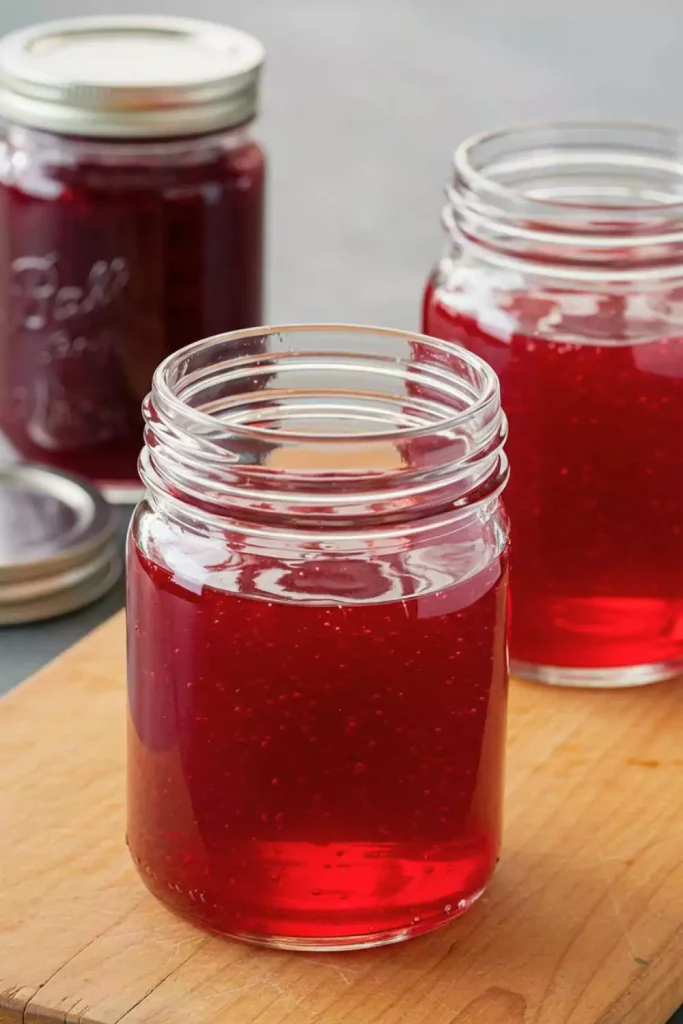There’s nothing more frustrating than spending hours preparing jelly, only to find it hasn’t set the way you hoped. Instead of that beautiful, wobbly gel, you’re left with a runny, syrup-like mixture.
If this has happened to you, don’t worry—you’re not alone.
Making jelly is both an art and a science. Even experienced home cooks occasionally face this issue. The good news is that most of the reasons are easy to understand and fix.
In this post, we’ll explore the most common reasons your jelly didn’t set and go through practical ways to rescue it.
Why Did My Jelly Not Set?
1. It Needs More Time
Patience is key. Many people expect jelly to firm up as soon as it cools, but that’s not always the case.
Depending on the fruit, sugar content, and room temperature, it can take 24 to 48 hours for jelly to fully set. If your batch still looks soft after a few hours, don’t give up.
Put one jar in the refrigerator overnight and check it the next day. Sometimes, time alone solves the problem.

2. Cooking Time Was Off
Jelly depends heavily on cooking temperature and timing.
- Undercooking: If you didn’t heat it long enough, the pectin in the fruit didn’t activate. Without that, the mixture can’t gel.
- Overcooking: Too much heat can break down the pectin molecules, leaving you with syrup instead of jelly.
To avoid this, use a gel test. Place a spoonful of jelly on a cold plate, let it cool for a minute, and then push it gently with your finger. If it wrinkles, it’s ready. If it runs, it needs more cooking.
3. Pectin Problems
Pectin is the natural fiber that gives jelly its structure. The problem is, not all fruits have the same amount. Apples, citrus peels, and plums are high in pectin, while strawberries, cherries, and peaches are much lower.
If you used a low-pectin fruit without adding extra, it might not set.
Another common mistake is using old or expired pectin. Pectin loses its effectiveness over time, so if it’s been sitting in your pantry for years, it may not work as expected.
4. Sugar and Acid Balance
Sugar isn’t just for sweetness—it’s essential for structure. It binds with pectin and helps the jelly set. If you cut down the sugar too much, your jelly may never firm up.
On the other hand, adding too much sugar can interfere with the process as well.
Acid is equally important. Without the right level of acidity, pectin can’t form the bonds it needs.
If your fruit isn’t naturally tart, add lemon juice to balance things out. It makes a huge difference in how well your jelly sets.
5. Fruit Characteristics
Every fruit is unique. Even the same type of fruit can behave differently depending on how ripe it is.
Overripe fruit, for example, has less natural pectin than just-ripe fruit. If your jelly didn’t set, the fruit itself may be the reason.
This is why many recipes recommend combining high-pectin fruits with low-pectin ones or using added pectin to guarantee success.
How to Fix Jelly That Didn’t Set
Re-Boil With Pectin
The most reliable fix is to re-boil the jelly with more pectin. Mix your jelly with a bit of sugar, lemon juice, and powdered or liquid pectin.
Please bring it back to a rolling boil for at least one minute, then re-test using the plate method. This usually works for batches that came out too soft the first time.
Work in Smaller Batches
If you made a big batch, don’t try to re-cook it all at once. Divide it into smaller portions—around 4 cups at a time.
Jelly thickens more evenly this way, and it’s easier to control the cooking.
Fix Without Pectin
If you don’t have pectin on hand, you still have options. Add a splash of lemon juice and re-boil the mixture for 5–10 minutes.
The acidity helps the natural pectin in the fruit do its job. Another trick is stirring in chia seeds. These absorb liquid and form a natural gel, plus they add fiber and nutrition.
Repurpose It Creatively
Sometimes, no matter what you do, the jelly refuses to set. That doesn’t mean you should throw it away. Runny jelly can be just as delicious in other forms. Try using it as:
- A topping for pancakes or waffles
- A sweet drizzle over ice cream
- A glaze for cakes or pastries
- A syrup for cocktails or lemonade
Think of it less as a failed jelly and more as a new homemade treat.
Conclusion
Jelly that won’t set can feel disappointing, but it’s a common challenge with an easy solution. In most cases, the problem comes down to timing, pectin levels, or the balance of sugar and acid.
The good news is that you can almost always fix it with a quick re-boil—or at least repurpose it into something equally delicious.
The next time you make jelly, keep these tips in mind. With the right balance of ingredients and a little patience, you’ll end up with jars of perfectly set jelly every time.